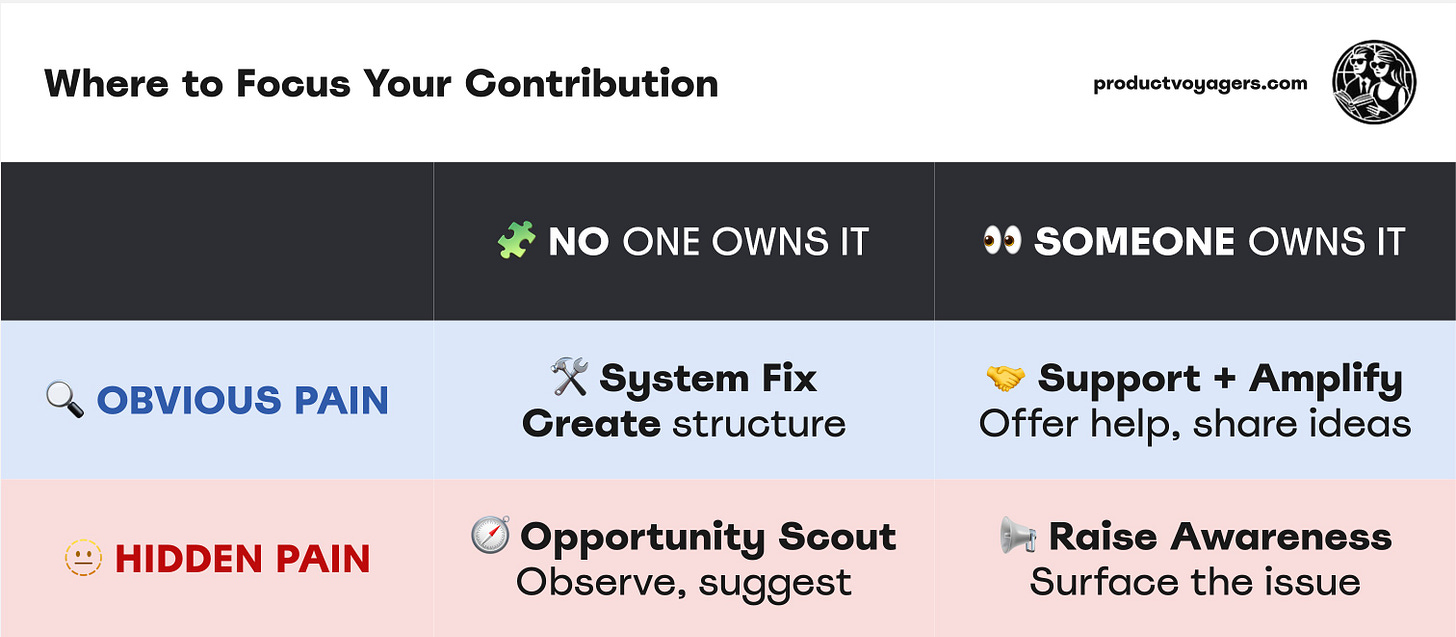Community Contribution: The Invisible Skill That Accelerates Product Careers
What great product people do that no one asks for.
As a product manager, it’s easy to get caught in the daily grind — hopping between meetings, writing tickets, answering questions, preparing sprint demos, and managing the latest fires. As you grow into product leadership, the nature of the chaos shifts. You spend more time in leadership calls, discussing strategy, handling OKRs and escalations — and it becomes even easier to lose touch with what’s happening on the ground.
But no matter your level, one thing remains true: your job isn’t just to manage the work — it’s to shape the ecosystem where that work happens.
Let me share a situation that illustrates this.
When the System Fails the Team
Some time ago, a product manager reached out to me for support. Their team was drowning in work — not because of the size of their roadmap, but because of the noise surrounding it.
Requests were coming in from all directions: stakeholders dropping in with high-priority items mid-quarter, small ad-hoc asks with unclear value, and constant pings on Slack. Engineers were fielding questions directly and occasionally agreeing to “quick wins,” which stakeholders took as a green light to bypass the product team. On top of that, the product sat at the intersection of multiple domains, which meant a steady flow of bug reports, integration questions, and general confusion.
Everyone was busy. Everyone was exhausted. And no one felt in control.
So we zoomed out and started asking:
How is work being planned and communicated?
How are ad-hoc requests triaged?
How does the team know where they’re making an impact?
It quickly became clear: they weren’t failing at execution — they were missing structure. There were no agreed boundaries, no framework for handling unexpected work, and no shared understanding across teams. The team had no tools to protect their focus — and no one had stepped in to create those tools.
This is where community contribution comes in.
The Work Beyond the Work: What Community Contribution Really Means
At many companies, especially in product and engineering, community contribution refers to the work you do beyond your immediate team — the kind of impact that improves the system around you. It might mean creating better processes, sharing knowledge, mentoring others, or building tools and rituals that help multiple teams work better.
In the example above, what was missing wasn’t effort — it was someone stepping up to improve the ecosystem around the team: setting clearer expectations with stakeholders, designing lightweight intake processes, or creating visibility into planning cycles. That kind of work might not show up on a sprint board, but it’s often what separates a good team from a great one — and what makes someone stand out when it comes to performance reviews or promotions.
Why Community Contribution Matters
Community contribution matters because it shows:
Initiative: You see problems beyond your lane and act on them.
Leadership: You create systems that help others succeed.
Leverage: You raise the bar for more than just your team.
It’s often a sign that someone is ready for the next step — because they’re not just delivering outputs, they’re shaping the environment in which outcomes are delivered.
In this article we will cover:
What Community Contribution Looks Like at Different Levels
Spotting Contribution Moments in Your Day-to-Day — No Matter Your Level
Guiding Questions to Uncover Contribution Moments
This is a free edition of The Product Voyagers. To unlock full playbooks, tools, templates and expert takes — go Prime.
🧗♀️ What Community Contribution Looks Like at Different Levels
💡 A note before we dive in: Community contributions don’t have to be big, visible projects. Sometimes, the most impactful contributions are simple changes that improve how people work together. What matters is that you're thinking beyond your personal backlog and helping create a better environment for others.
Product Manager (Junior to Mid-Level)
🛠 Contributing to your immediate team and cross-functional peers
Creating or improving onboarding materials for engineers or new team members
Proactively documenting product areas that are hard to understand or prone to repeat questions
Organizing knowledge-sharing sessions like demos or deep dives
Helping define or clarify team rituals (e.g. improving how sprint reviews are done)
Raising recurring process gaps and proposing lightweight solutions
Sharing useful insights, tools, or templates with peers
Senior Product Manager
🌱 Contributing across teams and helping others grow
Coaching or mentoring junior PMs or interns
Standardizing how your team handles stakeholder intake or ad-hoc requests and sharing the model with others
Running cross-team initiatives (e.g. shared planning or sync meetings with adjacent teams)
Leading post-mortems and turning learnings into best practices
Driving product quality or customer experience initiatives across teams
Hosting internal talks or writing posts to share lessons learned
Lead Product Manager
📐 Shaping product practices across multiple teams or domains
Creating scalable frameworks for roadmap planning, OKRs, or prioritization
Introducing governance or alignment rituals across several product teams
Acting as a “go-to” for difficult cross-team decisions and trade-offs
Building reusable documentation or templates that multiple teams adopt
Leading internal product circles, forums, or chapters
Partnering with design/engineering leads to improve cross-functional collaboration patterns
Group Product Manager
🌉 Creating cohesion and raising standards across a portfolio of teams
Defining or evolving team structures, roles, and scopes
Scaling onboarding and mentoring practices across your area
Introducing shared KPIs or operating models for cross-team collaboration
Leading org-wide retrospectives or strategy alignment efforts
Improving how product, design, and engineering triads collaborate at scale
Driving a culture of experimentation, user discovery, or other strategic capabilities
Product Director
🏗 Shaping the broader product organization and strategy
Designing and rolling out planning processes or prioritization cadences across the org
Championing team health and improving how the org handles burnout, capacity, or focus
Building bridges across departments (e.g. product <> marketing <> sales) to reduce silos
Advocating for PM career development programs, coaching structures, or role clarity
Creating space for PMs to do deep work (e.g. by reducing unnecessary rituals or aligning leadership expectations)
Representing the product org in cross-functional exec settings with clarity and empathy
Senior Product Director
🌍 Scaling the culture, systems, and strategy of the entire product organization
Redesigning how the company approaches product planning, product reviews, or OKRs
Creating long-term org design strategies (e.g. when to spin out teams or consolidate scope)
Introducing new career tracks, leveling guidelines, or promotion frameworks
Driving major cultural shifts, such as how the company makes product bets or handles risk
Coaching and mentoring other product leaders to scale leadership across the org
Representing the product function externally — via hiring, industry events, or executive-level partnerships
Spotting Contribution Moments in Your Day-to-Day, No Matter Your Level
Community contribution doesn’t require a fancy title or special permission. It starts with awareness: noticing where things feel off and asking, “Is there something I could improve here?”
Before you jump into action, take a moment to reflect on where the opportunity lives. The quadrant below helps you assess the situation based on two dimensions:
Is the problem obvious or still hidden?
Is someone already owning it, or is it falling between the cracks?
🧭 The Contribution Opportunity Quadrant
How to read it:
🛠 System Fix → Something’s clearly broken and no one’s solving it. Step in. Design a process, set expectations, fix the gap.
🤝 Support + Amplify → Someone is already improving things. Join them. Help scale or improve their approach.
🧭 Opportunity Scout → You’ve noticed friction others haven’t. Stay curious. Test small changes and observe the ripple effects.
📢 Raise Awareness → You see an issue, but it’s under the radar. Share it thoughtfully. Spark conversations and offer ideas.
Most meaningful contributions start in the “No one owns it” zone. That’s where leadership starts — at any level.
Guiding Questions to Uncover Contribution Moments
Once you’ve located a potential opportunity in the quadrant, use these prompts to reflect further:
👀 1. What do I keep hearing?
Look for repeated patterns of frustration or confusion.
Are people asking the same questions over and over?
Are stakeholders unclear about how to engage with your team?
Is there a ritual or meeting that everyone dreads or avoids?
Are engineers or designers complaining about how something works (or doesn’t)?
These are signs that something needs clarification, structure, or a better way.
🔄 2. Where does the system break down?
Zoom out from tasks and look at the system around them.
Are there constant last-minute changes, rework, or planning chaos?
Are teams making decisions in silos or duplicating work?
Are you or others constantly firefighting the same types of issues?
When the system doesn’t support the people in it, it’s a chance to design something better.
🧭 3. Where am I uniquely positioned to help?
You don’t need to fix everything — just what’s within reach.
Is there something I’ve figured out that others could benefit from?
Is there a small thing I can organize, write down, or clean up?
Do I have insight from my role that others might not have?
Start where you have context, and build from there.
🌱 4. What will make the environment better for others?
Think beyond your goals — think about the system you're part of.
What would make onboarding smoother for someone new?
What process could help teams collaborate more effectively?
What knowledge could I document or share to unblock others?
Improving the environment is often more impactful than solving the next ticket.
🕊 5. Is there space for something better — if I create it?
Sometimes the change won’t happen unless you start it.
Could I suggest a new ritual, sync, or doc that saves time for others?
Can I open a conversation about how we work — not just what we work on?
Is there a gap that nobody owns, but everyone struggles with?
Contribution often starts with noticing, and acting on, those gaps.
🐝🍀 Your Role in Shaping the Ecosystem
Whether you’re early in your product career or leading large teams, your ability to shape the environment around you is one of the most powerful ways to grow.
Every team has friction. Every org has gaps. But not every person chooses to do something about it. That’s your chance — not to take on more, but to make things better.
Community contribution isn’t extra work — it’s the work of building a better system for everyone.
What’s one thing in your environment that you could make just a bit better this week?





